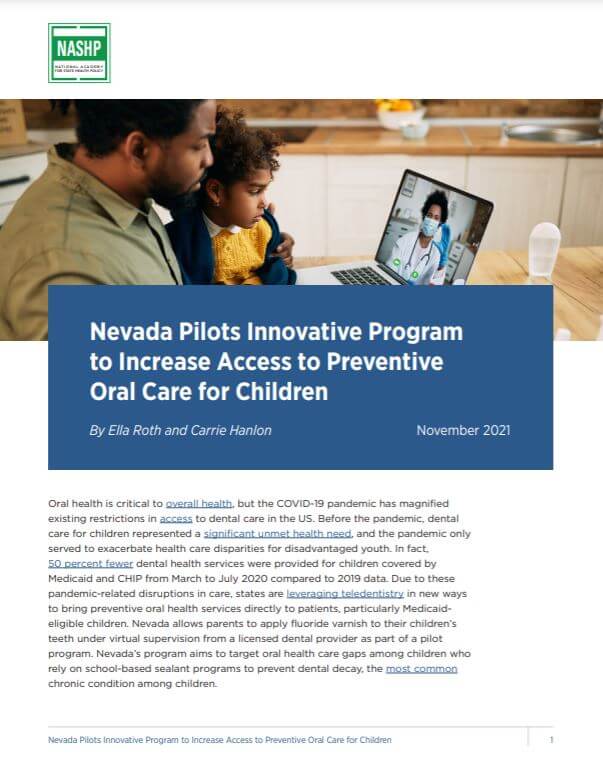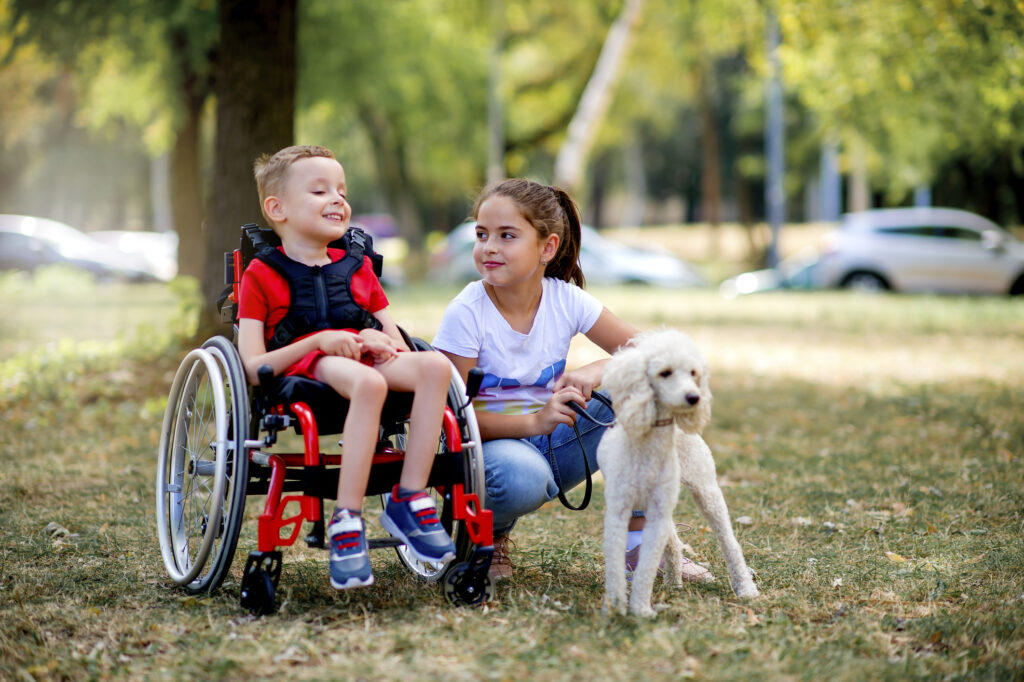Oral health is critical to overall health, but the COVID-19 pandemic has magnified existing restrictions in access to dental care in the US. Before the pandemic, dental care for children represented a significant unmet health need, and the pandemic only served to exacerbate health care disparities for disadvantaged youth. In fact, 50 percent fewer dental health services were provided for children covered by Medicaid and CHIP from March to July 2020 compared to 2019 data.
Due to these pandemic-related disruptions in care, states are leveraging teledentistry in new ways to bring preventive oral health services directly to patients, particularly Medicaid-eligible children. Nevada allows parents to apply fluoride varnish to their children’s teeth under virtual supervision from a licensed dental provider as part of a pilot program. Nevada’s program aims to target oral health care gaps among children who rely on school-based sealant programs to prevent dental decay, the most common chronic condition among children.
Overview of Pilot Program
Nevada has experienced several oral health challenges during the COVID-19 pandemic. Along with widespread school closures, school-based sealant programs, which provide critical preventive care for students (particularly low-income individuals and children of color), were suspended. Provider shortages due to the pandemic also exacerbated oral health care gaps in Nevada, as very few dental providers participate in the Medicaid program and Medicaid rates for dentistry were part of overall budget-saving packages due to pandemic-related budget shortfalls. Additionally, only one county in Nevada has total community water fluoridation, which stakeholders considered another reason to increase access to preventive dental care for Nevadans.
Concerns for the oral health of school-aged children in the face of these challenges led to the creation of the Nevada Action Network pilot program allowing parental caregivers to apply fluoride varnish to their child’s teeth with virtual instruction from a licensed dental provider.
Nevada Action Network is executed by LIBERTY Dental Plan of Nevada (LIBERTY), the state’s Medicaid dental benefits administrator (DBA), through a partnership with the Nevada Division of Public and Behavioral Health (DPBH) Oral Health Program. The Nevada Action Network leaders submitted a proposal to the Nevada State Board of Dental Examiners (NSBDE) to move forward with the fluoride varnish program. In October 2020, NSBDE approved the proposal to allow home fluoride varnish applications with virtual supervision from Nevada dental practitioners.
The program, which officially launched in January 2021, allows caregivers of Medicaid enrollees under the age of 21 to schedule a virtual check-up with a dental professional and receive an at-home fluoride kit. The registration page for the program offers videos on oral health and fluoride varnish. Parents/guardians who schedule a virtual dental appointment for their child will receive a fluoride varnish packet and an oral health educational brochure in the mail. A licensed dental professional provides an oral exam, collects oral health information, and instructs the parent or caregiver to apply fluoride varnish to the child’s teeth via a virtual teledentistry platform. The dental provider collects oral health information from each patient, including clinical findings and a surveillance survey about recipients’ oral health needs, nutrition, oral health habits, and return to dental office hesitancy due to the pandemic. Parents can register for an appointment and fluoride kit here.
Program Providers and Services
Services and Billing Codes
A licensed Nevada dentist or public health endorsed dental hygienist works through a virtual HIPAA compliant platform to perform:
D0190: Screening of a patient
D1330: Oral hygiene instructions
D1206: Parent/guardian serves as a dental assistant and applies fluoride varnish to their child’s teeth, with instruction from a licensed dental provider
D0601, D0602, or D0603: Low, medium, or high caries risk assessment
Medicaid-enrolled dentists and public health endorsed dental hygienists in Nevada are eligible to enroll in the Nevada Action Network program and receive training. Public health endorsed dental hygienists are permitted to provide oral health services without supervision for the “promotion of public health dental hygiene” if they provide services at public health locations such as schools and community centers as authorized under Nevada’s regulations. Nevada Medicaid reimburses enrolled dental providers to mail the at-home fluoride kit, conduct the virtual oral health screening, and instruct caregivers as they apply fluoride varnish to the child’s teeth. Dental assistants in Nevada are not licensed. Accordingly, parents are allowed to apply fluoride varnish because they function as a dental assistant working under the virtual supervision of a licensed dental provider when applying varnish to their child’s teeth in this program.
Early Lessons and Recent Activity
Several factors facilitated the creation of Nevada Action Network. Nevada has only one DBA, and that DBA, LIBERTY, had a pre-existing partnership with DPBH. In 2019, LIBERTY began working with school-based health services groups and collaborated with DPBH to train all school nurses in the Washoe County school district on oral health screening, care coordination, and fluoride varnish application. Although implementation of the Washoe County school-based program was stalled in 2020 due to COVID-19, LIBERTY leveraged the training and other experiences from that partnership for the Nevada Action Network.
As the Nevada Action Network launched in January 2021, program leaders initiated outreach to increase awareness of this innovative preventive dental care opportunity through advertisements, billboards, media buys, flyers, and promotion in Medicaid redetermination letters. Program leaders stated that partnering with state agencies and school-based sealant programs, which have acted as main providers of Nevada Action Network teledental visits while school programming has been suspended, has also been key to increasing awareness of the program. Outreach challenges include maintaining up-to-date contact information for families and navigating the state text message requirements that families opt in before receiving text messages from Medicaid or LIBERTY. Program leaders also noted the importance of proactive outreach and ongoing marketing and communication to families, which requires consistent funding. Nevada health officials identified sending back-to-school care packages with information about the program as a potential next step to address outreach challenges.
In March 2021, NBDE extended its approval of the program to 2022 after receiving letters of support from many partners, including the Nevada Dental Hygienists’ Association, Nevada Dental Association, the nonprofit school-based sealant program Future Smiles, and multiple dental providers, among others.
Health officials supporting the Nevada Action Network also helped advance legislation that would enhance dental access through teledentistry. A bill that was passed by the Nevada legislature in 2021, SB 391, would have defined teledentistry, established teledentistry guidelines, allowed Medicaid reimbursement of teledentistry (beyond what is permissive for the pilot program), and created a Committee on Dental Emergency Management to govern the practice of dentistry during an emergency. The governor eventually vetoed this bill in June 2021 because of concerns around provisions that would exempt the committee from holding meetings open to the public during an emergency, which conflicts with Nevada’s Open Meeting Law. The Nevada Action Network will continue for now, but officials noted that the future is uncertain without statewide teledentistry guidelines.
Conclusion
Although the long-term viability of the Nevada Action Network is unclear, program leaders report an ongoing need for this program, especially in areas where school-based sealant programs permanently closed as a result of the pandemic. Early feedback from participants is positive. For some parents/guardians, this method of service delivery provided them with the opportunity to ask questions about their child’s dental health and habits in the place where home toothbrushing occurs and receive professional guidance while examining their child’s mouth, many for the first time. Additionally, program leaders stated that multiple stakeholders maintain interest in continuing the intervention. Indeed, partnerships with community organizations, academic partners, and state agencies were crucial to moving forward with teledentistry bill language and the program as a whole.
Twenty-three states currently have teledentistry legislation in place, and Nevada’s unique fluoride varnish pilot program has sparked interest in states that aim to increase access to dental care for children enrolled in Medicaid. As the Nevada model relies on the unlicensed dental assistant provider category, variations on the model may need to be considered. Those states with that unlicensed category could consider adopting a similar program. Innovative use of teledentistry to increase access to preventive care among underserved children, such as the Nevada Action Network, will likely continue as the oral health sector adapts to changes brought on by the pandemic.
Acknowledgments
The authors thank Dr. Antonina Capurro and Dr. Amy Tongsiri who provided information and feedback for this publication and were the program creators and project administrators for the Nevada Action Network. Additionally, we thank Allie Atkeson and the Health Resources and Services Administration officials who provided thoughtful input. This project is supported by the Health Resources and Services Administration (HRSA) of the US Department of Health and Human Services under grant number U2MOA394670100, National Organizations of State and Local Officials. This information, content, or conclusions are those of the authors and should not be construed as the official position or policy of, nor should any endorsements be inferred by HRSA, HHS or the US government.
Fluoride varnish is a highly concentrated form of fluoride that is painted on teeth to prevent tooth decay. According to American Dental Association (ADA) clinical recommendations, fluoride varnish is a highly effective and safe intervention. Licensed dental professionals such as dentists and dental hygienists can provide this preventive service. Additionally, pediatric medical providers may apply fluoride varnish for young children.




